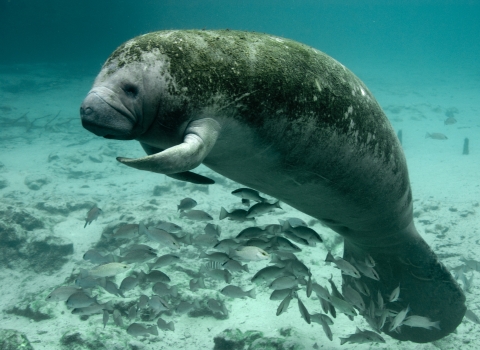Sacramento, Calif. — The U.S. Fish and Wildlife Service today announced more than $66.7 million in grants to 16 states and Guam to support land acquisition and conservation planning projects on over 13,500 acres of habitat for 162 listed and at-risk species through the Cooperative Endangered Species Conservation Fund. The grants will be matched by more than $35.1 million in partner funds.
Nearly 60% of that funding, over $39 million, will be invested in preserving habitat, land use planning efforts for wildlife and people, and conserving species in California.
“These grants will enable state and territorial fish and wildlife agencies and their partners to advance the stewardship of our nation’s most imperiled species and the habitats upon which they depend,” said Service Director Martha Williams. “This cooperative approach to conservation demonstrates a shared commitment to the Endangered Species Act's purpose of protecting biodiversity.”
The competitive grants funded through the Cooperative Endangered Species Conservation Fund help states with various efforts to help imperiled wildlife. Habitat Conservation Plan Land Acquisition Grants and Recovery Land Acquisition Grants support the permanent protection of habitat for listed and at-risk species to complement conservation strategies of approved plans. The funding also supports the development, renewal or amendments of Habitat Conservation Plans, safe harbor agreements and candidate conservation agreements with assurances through the Conservation Planning Assistance Grants.
Full list of grants awarded in California FY 2022
Habitat Conservation Plan Land Acquisition Grants
- Carlsbad Habitat Management Plan, North County Multiple Habitat Conservation Plan
- Chula Vista Multiple Species Conservation Program Subarea Plan Phase 1
- Coachella Valley Multiple Species Habitat Conservation Plan and Natural Community Coastal Conservation Plan
- East Contra Costa County Habitat Conservation Plan and Natural Community Coastal Conservation Plan
- Santa Clara Valley Habitat Conservation Plan and Natural Community Coastal Conservation Plan
- Seascape Uplands Habitat Conservation Plan: Larkin Valley Salamander Conservation Project
- Western Riverside County Multiple Species Habitat Conservation Plan
- Yolo Habitat Conservation Plan and Natural Community Coastal Plan Giant Garter Snake Easement Acquisition (subject to availability of funds)
Project spotlight: Western Riverside Multiple Species Habitat Conservation Plan
The state of California will receive nearly $4.4 million under the Habitat Conservation Plan Land Acquisition Grant Program to acquire and permanently protection of up to 737 acres of habitat as part of the Western Riverside County Plan. The proposed acquisitions are in ecologically significant, high-priority conservation areas that support key populations of covered species such as San Jacinto Valley crownscale, spreading navarretia, coastal California gnatcatcher, thread-leaved brodiaea, Stephens’ kangaroo rat and western spadefoot toad.
Complementing this grant are two active projects funded through the Traditional Conservation Grant program. These projects include conducting distribution and abundance surveys, along with habitat suitability and population models for the federally endangered San Jacinto Valley crownscale and threatened spreading navarretia.
Recovery Land Acquisition Grants
- Purisima Hills Conservation Easement Project
Project spotlight: Purisima Hills Land Acquisition
More than $3.6 million will support the acquisition and permanent protection of approximately 566 acres in Santa Barbara County, Calif. through a conservation easement conservation easement
A conservation easement is a voluntary legal agreement between a landowner and a government agency or qualified conservation organization that restricts the type and amount of development that may take place on a property in the future. Conservation easements aim to protect habitat for birds, fish and other wildlife by limiting residential, industrial or commercial development. Contracts may prohibit alteration of the natural topography, conversion of native grassland to cropland, drainage of wetland and establishment of game farms. Easement land remains in private ownership.
Learn more about conservation easement . This property contains important habitat for the Santa Barbara Distinct Population Segment of the federally endangered California tiger salamander. The property provides several breeding ponds along with scrub and oak woodlands. This combination of aquatic and upland habitat is needed for the life cycle of this species. Additionally, conservation of the property connects to a matrix of existing protected lands, promoting landscape connectivity and movement of wildlife, including the California tiger salamander.
Conservation Planning Assistance Grants
- East Contra Costa County Habitat Conservation Plan Amendment
- Livermore Habitat Conservation Plan
- Santa Catalina Island Fox Habitat Conservation Plan
- Santa Clara Valley Habitat Conservation Plan and Natural Community Conservation Plan Amendment
- Sweetwater Authority Natural Community Conservation Plan and Habitat Conservation Plan
Project spotlight: Balancing conservation and development through the development of a Habitat Conservation Plan for the City of Livermore
A Conservation Planning Assistance grant of $700,000 will support the development and implementation of a Habitat Conservation Plan for the city of Livermore, Calif. The plan is anticipated to significantly streamline the city's routine maintenance and capital improvement program projects. This will allow the city to carry out critical infrastructure projects such a stream maintenance and road widening, while conserving important habitat and protecting listed and at-risk species such as California tiger salamander, California red-legged frog, palmate-bracted bird’s beak, and western pond turtle in Livermore and the surrounding area.
Formerly called the Habitat Conservation Plan Planning Assistance grants, in 2022, the Service broadened the program to include projects developing Safe Harbor Agreements and Candidate Conservation Agreements with Assurances, in addition the development of HCPs.
Authorized by Section 6 of the Endangered Species Act and partly funded through the Land and Water Conservation Fund, these grants contribute millions annually to support implementing state and territorial programs to conserve and recover federally listed and at-risk species on non-federal lands. This approach to conservation, done in cooperation with states, territories, willing landowners and local partners, furthers species conservation and economic development.
The U.S. Fish and Wildlife Service works with others to conserve, protect, and enhance fish, wildlife, plants, and their habitats for the continuing benefit of the American people. For more information about our work and the people who make it happen, visit https://www.fws.gov/cno/or connect with us via Facebook, Twitter, YouTube, and Flickr.






